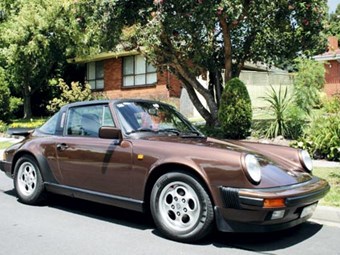Porsche 911 Carrera 3.2 Review - Our Shed
Our shed: Carrera capers. Kenwright wrestles with a mystery 911 gremlin

|
|
Porsche 911 Carrera 3.2
|
Porsche 911 Carrera 3.2
The 911 Carrera 3.2 was so effective because of its relatively powerful and very new DME engine management system. It is also why, at age 25, my car has the dubious honour of leaving me stranded as often as my old MGA did at the same age, making it equal-worst in this area of all the cars I've owned. My 1985 Carrera 3.2 provides a preview for those in the future who adopt anything from the late 1980s onwards as a classic.
I was prepared for the first failure after I watched its previous owner trying to hide the fact that the head temperature sensor (behind cylinder number three) had failed. It allowed the car to start flawlessly but within seconds would prevent it from idling below 2000rpm.
If you allowed it to stall, it would not start a second time without a long wait. After driving it home 800km without a worry because it never got a chance to cool down, it stalled at my place then refused to start again until it was fixed.
Five years of flawless running followed, until mid-last year when it didn't start first crank of the starter on a fresh battery, though a quick boost from my diesel ute kicked it into life.
Because all was well for several months, including the many stop-starts for the Unique Cars shoot for issue 317, I forgot about it.
Any smugness about my Porsche and Ponch's old VW arriving trouble-free several hours before the others was soon wiped away.
About a month later, the Porsche simply stopped in the middle of nowhere. Apart from the odd cough suggesting that it had spark and fuel, it would not go.
Then 10 minutes before the tow truck arrived, it started and ran flawlessly for another two months.
After eliminating any spark or fuel issues, I requested a full check over of the electronics at its next service as a precaution.
It was given a clean bill of health then literally on the way back from picking it up, it stopped in the middle of a busy intersection during a right-hand turn in peak hour!
This time it waited to come back to life as the tow truck arrived. Murphy's Law. Except this time it wouldn't start coming off the tow truck back at the Porsche specialist. At last, a chance to narrow it down.
Fuel, spark and everything else were quickly diagnosed as fine, except the engine wouldn't run unless we disconnected two cylinders.
It was then a short step to diagnose a faulty DME relay that lives under the passenger seat. It was sticking and not lighting up the engine management system enough for it to run properly, which accounted for the odd behavior over the previous six months. Date stamped 1985, it was the original, which is why I don't begrudge the $100 or so it cost to fix.
Yet before it failed totally, I faced the prospect of swapping fuel pumps and relays, draining the fuel tank, blowing out fuel lines, replacing the coil, plug leads, a range of sensors, computer and immobiliser when it was impossible to isolate the cause. That's the challenge with cars later than mine.
There is a growing range of hidden relays, control units, sensors and electronics in the fuel and ignition systems as well as in the cabin that can shut down without warning, then start up again.
And even if you are lucky enough to finally catch the culprit, chances are that the part has become obsolete and no longer available.
Unique Cars magazine Value Guides
Sell your car for free right here
Get your monthly fix of news, reviews and stories on the greatest cars and minds in the automotive world.
Subscribe

.jpg)









.png)



